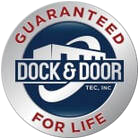|
1) ARTD. This is a feature called auto-return-to-dock and is available on hydraulic levelers and some basic mechanical EOD type levelers. On EOD’s it is not an issue as there is no extra charge and it is how most EOD units work. The hydraulic pit levelers are a different story. ARTD is an additional switch, secured to the leveler frame, located in the pit. This switch will activate the leveler if a truck departs from the dock with the leveler resting inside of it. On many brands and models, the ARTD switch can also be triggered manually by a person from outside of the building creating a security, safety and property damage risk!
In my 22 years of experience, I have yet to hear a valid reason for the ARTD. Of course, they are commonly sold and listed in specifications across the country. Put money on your bottom line don’t throw it in a dock pit. 2) Purchase a mechanical leveler. They are less costly upfront however over a ten year period they can cost twice as much as a hydraulic leveler, due to needed parts and repairs over the life of the equipment. As this is the lowest upfront option some buyers feel it is “good enough” and don’t realize how quickly repair costs can add up over ten years. Plus the downtime, headaches and safety issues with breakdowns and a mechanical spring-loaded device. 3) Purchase an under-capacity or too small of a dock leveler. It may even be called heavy duty, but if it is not heavy enough for your usage it won’t hold up to the rigors of forklift traffic and a loading dock environment. This leads to safety issues and unneeded service calls. Sure the right capacity will cost more upfront but it will pay for itself very quickly. Insist your provider gives you crystal clear information, from the manufacturer, which spells out the capacity you need. Keep in mind the static load rating is not the same as your usage, these are two different ratings. It is important to know the difference. Not all dock levelers are created equal. I would strongly encourage you to compare the spec or build sheets on the equipment as well as gain a full understanding of the structural design. 4) Utilize an inexperienced or low-buck installer to weld the leveler in or a concrete contractor to install the leveler to form a new dock leveler pit. There are two ways to construct a dock leveler pit, right and wrong. Many contractors take shortcuts because they bid the job low to get the work. Who pays in the long run when curb angles and concrete comes loose in five years? The same applies to the installation. Little things like proper and full welds on the shims make a big difference several years later. Regarding the concrete work and installation of a new leveler any reputable distributor/installer will offer a lifetime guarantee on their workmanship. Be sure you get this guarantee with your new leveler, to reduce your risks. We have estimated over 30% of the service calls we handle could have been avoided if the equipment would have been properly installed. Jay Anderson President, Dock & Door Tec, Inc. |
AuthorVarious. Categories
All
Archives
August 2023
|
- Home
- About
- Career Opportunities
- Services
-
Equipment
- Dock Locks (Truck Restraints) >
- Fans & In-Plant Equipment >
-
Industrial / Commercial Doors
>
- High Speed Fabric Doors
- Security High Speed
- Rubber Doors
- Fire Door
- Rolling Steel
- Impactable Dock Doors
- Cooler / Freezer
- Fabric Roll-Up
- Impact / Traffic / Bump
- Overhead / Sectional Doors
- Operators / Activation
- Air Curtains / Screen & Bug Doors
- Strip Doors
- Door Entrapment Protection
- Door Protection
- Overhead Door Upgrades
- Loading Dock Levelers & Lifts >
- Loading Dock Seals & Shelters >
- OEM & Aftermarket Parts
- Safety / Energy / Security / Employee Comfort >
- Yeti Snow Removal
- Markets
- Blog
- Contact
Dock & Door Tec
Serving Minnesota, Wisconsin, Iowa, North Dakota & South Dakota
Serving Minnesota, Wisconsin, Iowa, North Dakota & South Dakota

 RSS Feed
RSS Feed
